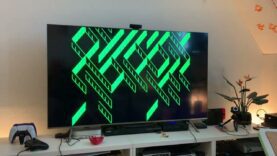“Back to Pet” Demo released at CAFe 2022 running on PET core on the MiSTer FPGA
Lactobacillus Prime
#PET #Demo #MiSTer
This single file Commodore PET demo got 1st at the CAFe 2022 Demo party. It shows what the standard Commodore PET is capable of using PETSCII characters and an attached beeper.
The Commodore PET (Personal Electronic Transactor) was one of the pioneering microcomputers of the 1970s. Introduced in 1977 by Commodore International, it holds historical significance as one of the first commercially successful personal computers.
Designed by Chuck Peddle and his team, the PET featured an all-in-one design, integrating a keyboard, monitor, and central processing unit (CPU) in a single enclosure. This compact design made it a self-contained computing system, setting it apart from other early microcomputers. The PET was available with different screen sizes, most notably the models with 9-inch and 12-inch green monochrome monitors.
It used the MOS 6502 microprocessor, which was a cost-effective and relatively powerful CPU for its time. The system typically had 4 to 8 kilobytes of memory (RAM), which was modest even for the standards of the day. Users could save and load programs using cassette tapes, a common storage medium at the time.
The PET’s built-in keyboard and monitor made it convenient for users to interact with the computer directly. Its text-based interface displayed 40 columns and 25 lines of monochrome text. BASIC (Beginner’s All-purpose Symbolic Instruction Code) programming language was the primary means of software development on the PET, making it accessible to a wide range of users, including educators, hobbyists, and small businesses.
Commodore’s marketing strategy targeted schools and businesses, positioning the PET as an educational and business tool. Its affordability, compared to mainframe computers, allowed smaller organizations to benefit from computing capabilities.
Despite its success, the PET had some limitations. The integrated design made it less flexible for expansion and upgrades compared to modular systems like the Apple II. Additionally, the monochrome display limited its graphical capabilities to PETSCII graphics.
The PET’s legacy continued with the release of subsequent models, such as the PET 2001 series and the later CBM series. These systems saw improvements in memory and peripherals, but they still adhered to the PET’s fundamental design principles.
As I don’t have a real PET computer at my disposal I opted to use a FPGA system to hardware simulate a real PET running the demo as it would on real hardware.
MiSTer FPGA System
The MiSTer project aims to recreate and emulate a wide range of classic computer and gaming hardware using field-programmable gate arrays (FPGAs) attempting to accurately replicate the behavior of vintage hardware, allowing enthusiasts to experience retro computing and gaming on modern displays with exceptional accuracy.
The foundation of the MiSTer project is the DE10-Nano board, developed by Terasic in collaboration with Intel. One of the key differentiators of the MiSTer project is its dedication to accuracy. Unlike traditional software-based emulators that mimic the behavior of vintage systems through code, FPGAs allow for a much closer approximation of the original hardware’s behavior. This means that the MiSTer project can replicate the idiosyncrasies, quirks, and timing intricacies of the original systems with remarkable precision.
The MiSTer project has garnered a dedicated community of enthusiasts, developers, and contributors who collaborate to develop and refine FPGA cores for various systems. The community continually improves these cores, enhancing compatibility, accuracy, and performance over time.
The MiSTer project’s versatility isn’t limited to gaming consoles. It also supports computer systems like the C64, Atari 800, BBC Micro, MSX, ZX Spectrum, Amstrad CPC, Amiga, Atari ST, Sharp X68000 and even early IBM PCs upto a 486 running Windows95, turning the DE10-Nano board into a flexible platform for experiencing a broad range of computing history & gaming.
Enjoy! Kudos to the creators of this wonderful example of modern day programming on an early 70s computer!
Thanks for watching – LactobacillusPrime
My Facebook:
https://www.facebook.com/LactobacillusPrimeRetroGaming
My Instagram:
https://www.instagram.com/lactobacillus_prime
NOTICE:
“Copyright Disclaimer Under Section 107 of the Copyright Act 1976, allowance is made for “fair use” for purposes such as criticism, comment, news reporting, teaching, scholarship, and research. Fair use is a use permitted by copyright statute that might otherwise be infringing. Non-profit, educational or personal use tips the balance in favor of fair use.”














